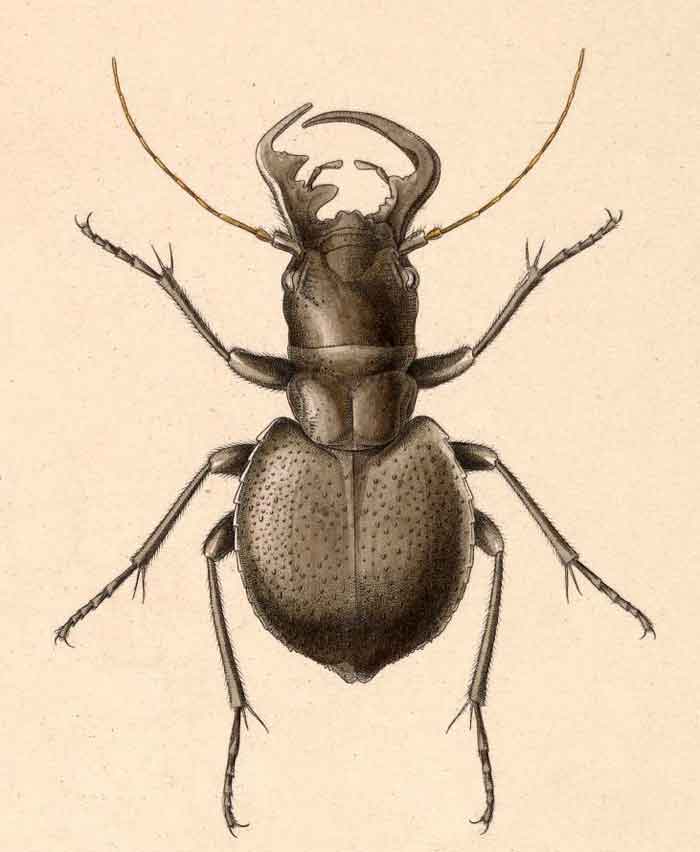Superregnum: Eukaryota
Regnum: Animalia
Subregnum: Eumetazoa
Cladus: Bilateria
Cladus: Nephrozoa
Cladus: Protostomia
Cladus: Ecdysozoa
Cladus: Panarthropoda
Phylum: Arthropoda
Subphylum: Hexapoda
Classis: Insecta
Cladus: Dicondylia
Subclassis: Pterygota
Ordo: Coleoptera
Subordo: Adephaga
Familia: Carabidae
Subfamilia: Cicindelinae
Tribus: Manticorini
Genus: Manticora
Species: M. congoensis – M. gruti – M. holubi – M. hrdyi – M. imperator – M. latipennis – M. livingstoni – M. mygaloides – M. scabra – M. sichelii – M. skrabali – M. tibialis – M. tuberculata – M. tyrannus – M. werneri
Name
Manticora Fabricius, 1781: 320
Type species: Manticora maxillosa Fabricius, 1781 (monotypy) [= Carabus tuberculatus DeGeer, 1778)

Manticora scabra
References
Primary references
Fabricius, J.C. 1781. Species insectorum; exhibentes eorum differentias specificas, synonyma, auctorum, loca natalia, metamorphosin ediectis observationibus, descriptionibus. Carol. Ernest. Bohnii, Hamburg and Kiel, vol 1: VIII + 552 pp. BHL Reference page.
Mareš, J. 1995. Determination key to the males of the genus Manticora Fabricius 1792 (Coleoptera, Cicindelidae). Acta Coleopterologica 11: 47–54.
Mareš, J. 2002. Manticora. A monograph of the genus. Taita Publishers, Ltd., Hradec Kralove. ISBN 8090273440
Mareš, J. 2019. Two new species and five new subspecies in the genus Manticora Fabricius (Coleoptera: Cicindelidae: Manticorini). Giornale Italiano di Entomologia 15(64): 231-240. Reference page.
Oberprieler, R.G. & Arndt, E. 2000. On the biology of Manticora Fabricius (Coleoptera: Carabidae: Cicindelinae), with a description of the larvae and taxonomic notes. Tijdschrift voor entomologie, 143: 71–89. PDF
Links
Manticora – Taxon details on Biological Library (BioLib).
Manticora – Taxon details on Global Biodiversity Information Facility (GBIF).
Manticora (often misspelled Mantichora (Latin term for "manticore") following an unjustified spelling change in 1837) is a well-known genus of tiger beetles that is endemic to Africa. Its members are the largest of the subfamily. All species are darkly colored, nocturnal, and flightless. Males usually have exaggerated mandibles compared to the females, used for clasping during copulation.
Taxonomy
This genus was among the first formally described by a pupil of Carl Linnaeus, Johan Christian Fabricius, in 1781.[2] The name Manticora comes from the ancient Persian for the legendary man-eating manticore. The first species of Manticora described was M. tuberculata, originally described by Charles De Geer in 1778 in the Linnean genus Carabus, to which it is only distantly related as presently defined. When Fabricius established Manticora he designated the species Manticora maxillosa, a junior synonym of M. tuberculata, as the type species.
Subsequently, numerous authors have described a number of additional species, subspecies, and variants, and the exact delimitation of taxa is highly disputed, with experts claiming as few as five species[3] and as many as 13,[2] though it seems the latter number is highly artificial, and not based upon objective criteria or DNA analyses.[4]
Species
Manticora contains the following species (under the most ambitious scheme;[2] alternative classifications only recognize as few as 5 taxa[3]):
Manticora congoensis Peringuey, 1888
Manticora gruti Bouchard, 1892
Manticora holubi Mareš, 2002
Manticora imperator Mareš, 1976
Manticora latipennis Waterhouse, 1837
Manticora livingstoni Laporte de Castelnau, 1863
Manticora mygaloides Thomson, 1859
Manticora scabra Klug, 1849
Manticora sicheli Thomson, 1859
Manticora skrabali Mareš, 2000
Manticora tibialis Boheman, 1848
Manticora tuberculata Geer, 1778
Manticora tyrannus Mareš, 2019
Manticora werneri Mareš, 2000
Manticoras in folklore and popular culture
Museum specimen of Manticora sp. from Mozambique.
Manticora tuberculata
In African folklore manticoras are evil creatures, often accused of being responsible for many bad things. According to legend they are doombringers. Some tribes even personify Death as a manticora whose mandibles are an equivalent to the European scythe of death (Mareš, Lapáček, 1980).
In Jules Verne's novel Dick Sand, A Captain at Fifteen, it is a Manticora beetle which helps Cousin Bénédict to escape from imprisonment, when the aforementioned, unguarded in a garden, follows the beetle. Since the beetle escapes from him by flying, it is possible that it is one of Verne's "scholar's jokes" (that is, a joke which only a scientist may recognize; see the entry Jules Verne) (Neff, 1978).
See also
Manticore
References
GBIF: Manticora
Mareš, Jaroslav (2002). Manticora: a monograph of the genus (Coleoptera, Cicindelidae, Manticorini). Taita Publishers. ISBN 978-8090273443.
Oberprieler, Rolf G.; Arndt, Erik (2000). "On the biology of Manticora Fabricius (Coleoptera: Carabidae: Cicindelinae), with a description of the larva and taxonomic notes" (PDF). Tijschrift voor Entomologie. 143 (1–2): 71–89. doi:10.1163/22119434-99900039. Archived from the original (PDF) on 9 February 2021. Retrieved 20 November 2015.
South African National Biodiversity Institute: assessment of Manticora conservation status
[1] (Beetles of Africa)
[2] (BioLib, Biological Library, a link to a page upon the Manticora genus
"Manticora Fabricius, 1792". Carabidae of the World. 2011. Archived from the original on 4 March 2016. Retrieved 29 June 2011.
Ing Jaroslav Mareš, Vlastimil Lapáček, Nejkrásnější brouci tropů (The most beautiful tropical beetles), Prague, (1980)
Ondřej Neff, Podivuhodný svět Julese Vernea (The Extraordinary World of Jules Verne), Prague, (1978)
Retrieved from "http://en.wikipedia.org/"
All text is available under the terms of the GNU Free Documentation License

